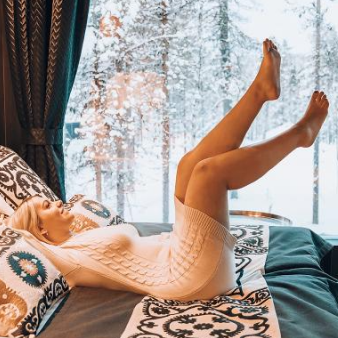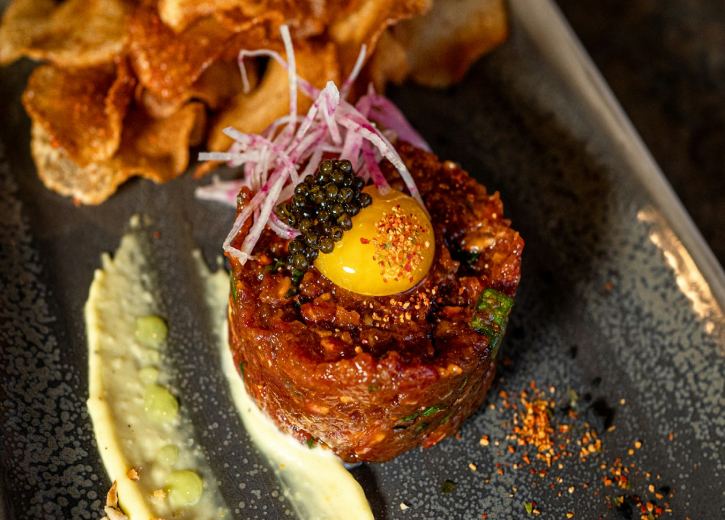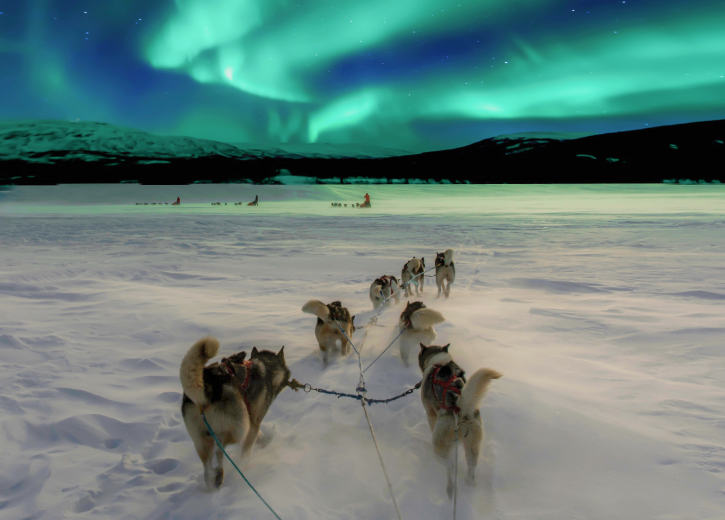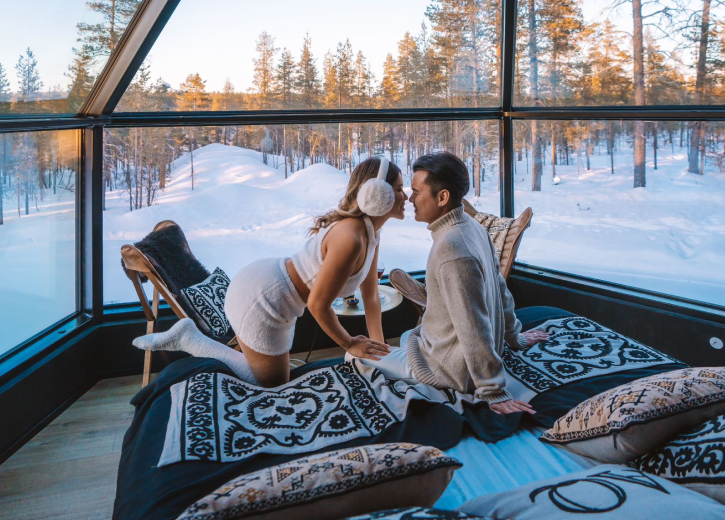For the best Northern Lights views in Lapland, stay in accommodations with clear views of the northern sky, away from light pollution. Glass-ceiling igloos and panorama suites in northern Finnish Lapland offer premium aurora viewing experiences without leaving your room. The regions of Inari, Kilpisjärvi, and Muonio are particularly renowned for excellent Northern Lights visibility due to their remote locations and minimal artificial light. The optimal viewing season runs from September to March, with December-February offering the darkest skies but coldest temperatures.
What makes Lapland the perfect destination for viewing the Northern Lights?
Lapland offers ideal Northern Lights viewing conditions due to its prime location directly under the aurora oval, the ring-shaped zone where auroral activity is most intense. This geographical advantage means the magical lights appear with much greater frequency and clarity than in locations further south.
The region’s minimal light pollution is another significant benefit. Most of Lapland consists of vast wilderness areas with very low population density, creating naturally dark skies that allow the aurora’s colours to shine brilliantly against the night canvas.
Lapland also boasts an extended aurora viewing season spanning from early September through late March. During this period, the dark polar nights provide ample opportunities to witness the dancing lights, with some areas experiencing nearly round-the-clock darkness during the winter months.
The pristine natural environment adds to the experience, with snow-covered landscapes reflecting the aurora’s colours and enhancing their visual impact. You might even spot a fox scampering across the snow beneath the glowing sky, completing the magical Arctic experience.
What types of accommodations offer the best Northern Lights viewing experience?
The best accommodations for Northern Lights viewing combine comfort with unobstructed sky views. Glass-ceiling igloos represent the pinnacle of aurora viewing luxury, allowing guests to watch the celestial display from the warmth of their bed. These purpose-built structures feature thermal glass that prevents frost formation while maintaining excellent insulation.
Panorama suites with large north-facing windows offer another premium option. These accommodations typically include spacious living areas with wide-angle views of the northern sky, perfect for families or those wanting more room than an igloo provides.
For a more rustic experience, wilderness cabins situated in remote locations offer exceptional viewing opportunities. While these may require stepping outside to see the full sky, they often come with private outdoor viewing areas, sometimes including hot tubs or heated terraces.
Traditional Lappish kota huts (teepee-like structures) with glass panels or removable sections provide a cultural dimension to aurora viewing. These authentic accommodations connect guests with the indigenous Sámi heritage while offering good visibility of the night sky.
For budget-conscious travellers, aurora camps and specialist hotels in dark-sky locations provide dedicated viewing platforms and equipment without the premium price of glass-ceiling accommodations.
When is the best time to visit Lapland for Northern Lights viewing?
The Northern Lights viewing season in Lapland spans from September to March, with each period offering distinct advantages. Late September to October provides a balance of reasonable temperatures (around 0°C) and increasing darkness, often with less cloud cover than midwinter and the chance to combine aurora viewing with autumn activities.
November to January delivers the darkest period, with the polar night (kaamos) bringing near-constant darkness in the northernmost regions. This maximizes potential viewing hours but comes with the trade-off of coldest temperatures, often dropping below -20°C.
February to mid-March offers increasingly reliable weather patterns with slightly warmer temperatures while still maintaining good darkness levels. This period also allows for combining aurora viewing with winter activities like skiing and snowshoeing during lengthening daylight hours.
Meteorological considerations are crucial regardless of when you visit. Clear skies are essential for aurora viewing, so planning a stay of at least 3-4 nights increases your chances of experiencing suitable weather conditions. Solar activity, which runs on an 11-year cycle, also influences aurora intensity, though impressive displays can occur at any point in the cycle.
How do you choose the right location within Lapland for aurora viewing?
Selecting the optimal location within Lapland requires balancing aurora visibility with practical considerations. Northern Lapland (particularly Finnish Lapland above the Arctic Circle) offers the highest frequency of aurora displays, with areas around Inari, Kilpisjärvi, and Utsjoki providing exceptional viewing opportunities due to their northerly position.
Consider the region’s typical weather patterns, as local geography creates microclimate variations. The northwestern “arm” of Finnish Lapland often experiences clearer skies than eastern areas due to the rain shadow effect of the Scandinavian mountains.
Accessibility is another important factor. While very remote locations may offer pristine viewing conditions, they might require challenging transportation arrangements, especially in winter. Areas with reasonable infrastructure like Muonio or Saariselkä balance excellent aurora conditions with practicality.
Consider complementary activities available in each region. Some areas excel in offering snowmobiling adventures or husky safaris, while others might provide better opportunities for experiencing Sámi culture or watching local wildlife like foxes in their natural habitat.
The level of light pollution varies significantly between locations. Even small villages can create enough ambient light to diminish aurora visibility, so accommodations several kilometres from settlement centres often provide superior viewing conditions.
What amenities should you look for in Northern Lights accommodations?
The most valuable amenity for serious aurora hunters is an aurora alert system. Premium accommodations often offer notification services that alert guests when the Northern Lights appear, allowing you to rest comfortably until the display begins rather than spending hours watching the sky.
Heated viewing areas significantly enhance the experience. Look for accommodations with insulated observation decks, glass-walled lounges, or heated outdoor platforms where you can comfortably observe the lights without battling extreme cold.
Specialised photography equipment availability can be a substantial benefit. Some properties offer tripods, wide-angle lenses, or even camera rentals with aurora-optimised settings, saving you from transporting bulky equipment.
Knowledgeable staff who can provide aurora forecasting information make a significant difference. They can advise on the best viewing times based on local conditions and scientific aurora prediction data.
Practical amenities like blackout curtains for daytime sleep (especially important during periods when you might stay up late for aurora viewing), proper heating systems, and in-room hot drink facilities enhance comfort during your northern adventure.
What should you pack for a Northern Lights viewing trip to Lapland?
Proper clothing is absolutely essential for comfortable aurora viewing in Lapland’s sub-zero temperatures. The key is layering – pack thermal base layers (merino wool is excellent), multiple mid-layers of fleece or wool, and a windproof, insulated outer layer. Don’t forget insulated snow trousers, as your legs get particularly cold when standing still.
Extremity protection deserves special attention. Pack insulated, waterproof boots rated for at least -30°C, wool socks (bring several pairs), insulated gloves with liners, a warm hat that covers your ears, and a balaclava or scarf to protect your face from biting winds.
For photography, bring a camera with manual settings capability (smartphone cameras have improved but dedicated cameras still perform better), a sturdy tripod (essential for long exposures), spare batteries (cold drains them quickly), and a remote shutter release to avoid camera shake.
Personal comfort items make a big difference: hand and foot warmers, a thermos for hot drinks, a headlamp with red light mode (to preserve night vision), and eye masks for sleeping during daylight hours if you’re adjusting your schedule for night viewing.
Don’t forget practical items like lip balm and heavy-duty moisturiser to combat the dry Arctic air, sunglasses for daytime (the snow reflection is intense), and any medications you might need, as pharmacies can be far between in remote Lapland locations.
Ready to Experience the Magic of the Northern Lights?
After learning about the perfect conditions for viewing the Northern Lights in Lapland, why wait any longer to experience this breathtaking natural phenomenon? Aurora Queen Resort offers the ideal combination of premium accommodations, expert guidance, and prime location for witnessing the dancing lights of the aurora borealis.
Our glass-ceiling igloos and panorama suites provide the ultimate comfort while maximizing your chances of spotting the Northern Lights from the warmth of your own accommodation. Our experienced staff, aurora alert systems, and carefully selected location away from light pollution ensure you’ll have the best possible aurora viewing experience.
Book your unforgettable Northern Lights holiday now and prepare for a magical Arctic adventure that will create memories to last a lifetime. Spaces fill quickly during prime viewing season, so secure your perfect Lapland getaway today!



